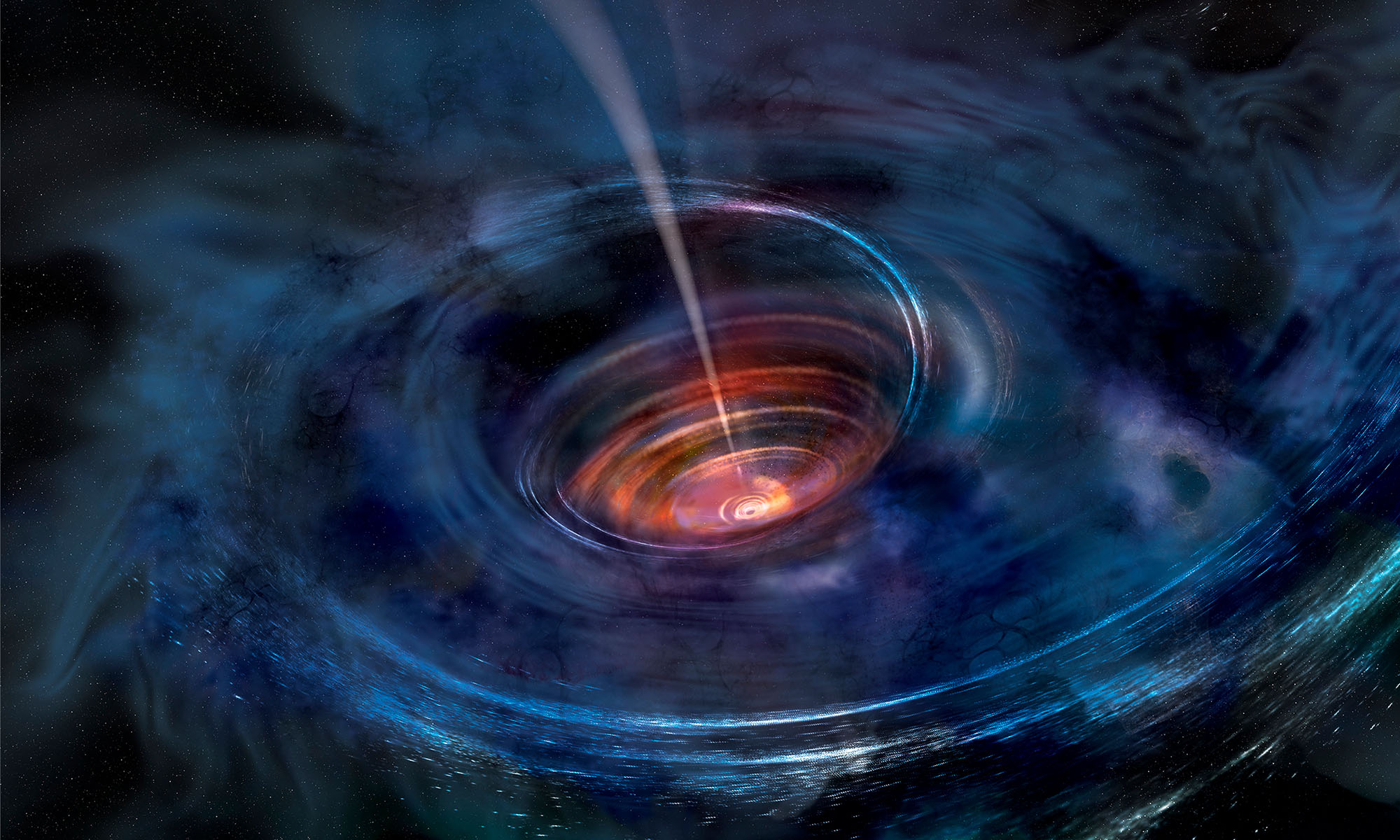With considerable involvement of UF researchers, the Laser Interferometer Gravitational-Wave Observatory, or LIGO, has detected two “chirps” of gravitational waves — a cute phrase for an epic cosmic event, the merger and collapse of two black holes.
The chirps are the first time scientists have detected gravitational waves and give compelling evidence in support of Albert Einstein’s general theory of relativity, and the discovery has established gravitational astronomy as an exciting new field of study.
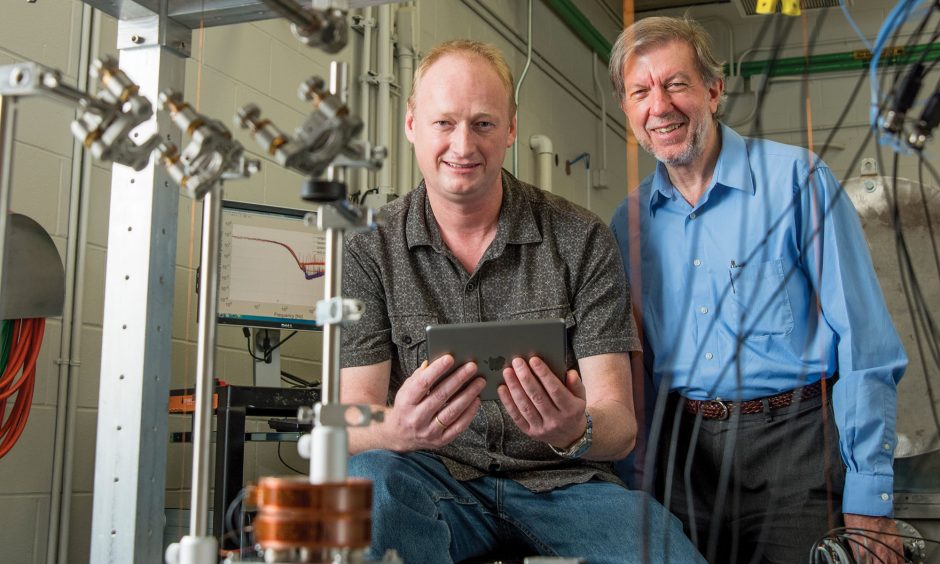
The general theory of relativity posits that gravity moves at the speed of light (671 million miles per hour), disturbing the fabric of space-time. Distortions in this fabric are caused by immense gravitational force such as that created by a black hole. Einstein proposed that when a large mass, such as a star, accelerates, it generates gravitational fields that are time-dependent and convert to wave energy that travels at the speed of light. A black hole, or a collapsed star, would generate an enormous amount of energy that would warp space-time. Until now, this phenomenon has been in the realm of theoretical physics and is the basis of time travel in films such as Back to the Future and Interstellar. LIGO’s research isn’t intended to help develop time travel, though; gravitational astronomers seek answers about the composition of the universe. “Imagine you live in a house, but you don’t know what all is in the house,” says UF physics professor Guenakh Mitselmakher, the principal investigator of the UF LIGO group who co-created the algorithm used by LIGO for the first detection. “Once you’ll explore, you’ll find something useful — ways to survive difficult situations. The universe is our house. We must go learn about our house.”
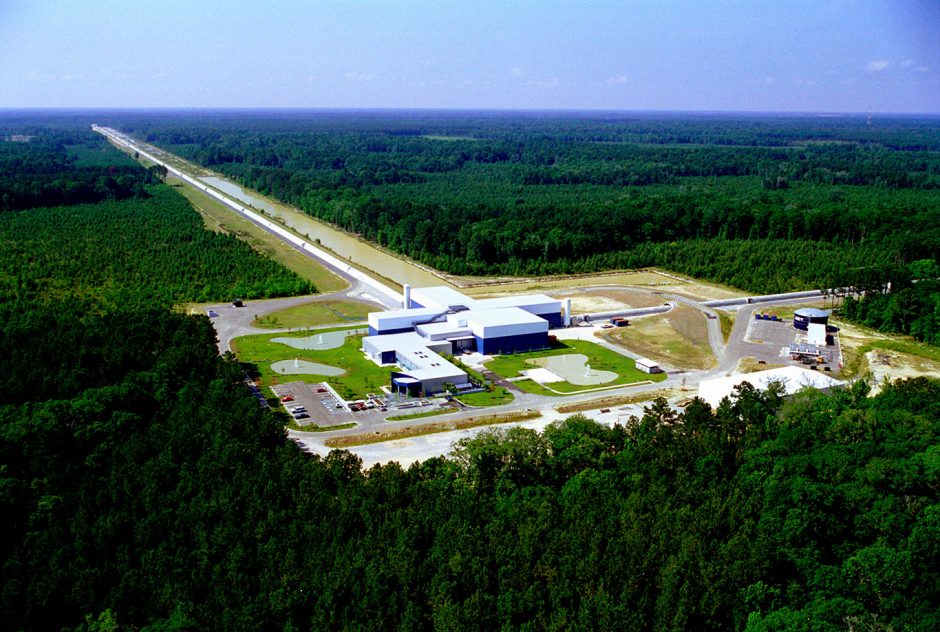
Scientists often use the metaphor of the ripples in a pond after a stone falls in to explain the gravitational effects on space-time. Typically, such ripples have been “seen” through radio astronomy, which measures the electromagnetic spectrum; that is, the stone has fallen into the water far from the shore, and astronomers observe the ripples from afar. For the first time, the ripples of gravitational waves have been detected without a telescope, as they arrived at the edge of the cosmic pond.
LIGO has been met with skepticism since its origins in the late 1980s, but through an international collaboration and the essential contributions of a team of UF physicists, it has finally achieved what seemed impossible: a snapshot of an ancient cosmic event. Advanced LIGO, a recent upgrade of the LIGO instruments in Louisiana and Washington State, had been online for less than 72 hours before the first chirp was detected on September 14, 2015. The team of roughly 1,000 scientists from around the world intended to operate the instruments in “engineering mode” for one month, but the universe had other plans. Two weeks before the “science mode” of the project was set to be deployed, the search algorithm developed at UF discovered a gravitational wave signal detected by twin LIGO interferometers. The finding was so unexpected that only after months of analysis did LIGO researchers confirm the waves produced by two merging black holes; the magnitude was enough that the chirp is very unlikely to be anything else, making the detection a monumental discovery. “I don’t think anything like that exists in any other field. This is a miracle,” says Sergey Klimenko, a professor of physics at UF who has worked to develop the detection algorithm with Mitselmakher since 1997.
The waves arrived at LIGO’s twin detectors within seven-thousandths of a second of each other, just past 4:50 a.m. in Livingston, La., and 2:50 a.m. in Hanford, Wash., showing that the two black holes, 29 and 36 times the mass of our Sun, had merged in a similar time frame after orbiting each other at a speed of approximately 100 orbits per second. While this may seem like current events, cosmically speaking, the collision occurred approximately 1.3 billion years ago.
The interferometer is a humorous yet accurate name: it involves the use of mirrors to split and reunite a laser beam, then reflect it back onto itself, which cancels out the light beam’s waves in a condition known as “anti-phase.” Because gravitational waves distort space, the distance between the mirrors changes, and the light goes out of anti-phase. That interference, however small, can be measured, albeit only after intense efforts to detect a tiny event in an enormous instrument. The LIGO detectors are approximately four kilometers wide, and the laser beams must be perfectly aligned to detect the wobble between the mirrors. It is striking that the mirror displacement caused by gravitational waves is 10,000 times smaller than the size of a proton and yet can be measured, says Klimenko.
The waves arrived within seven-thousandths of a second of each other … showing that the two black holes, 29 and 36 times the mass of our sun, had merged at a speed of 100 orbits per second.
Klimenko was brought onboard by Mitselmakher, who arrived at UF in 1995 to work in high energy physics. In 1995, David Tanner, along with fellow physics professors Bernard Whiting and David Reitze, responded to a call from Mitselmakher to join a LIGO research consortium led by Caltech and MIT. Guido Mueller joined the project in 1998. Funded by the consortium, UF was tasked with developing the input optics system for the interferometer (the largest funded experiment to date) and creating the crucial algorithm to interpret the signals it would receive. The team says they expected to first detect gravitational waves from a neutron star collision — the aftermath of a supernova. As the field was still theoretical at that time, “the challenge was to design an algorithm that can detect absolutely anything,” notes Mitselmakher. “It’s like looking for a black cat in a black room.” Laughs Tanner, “You just know it’s warm and fuzzy and may scratch.”
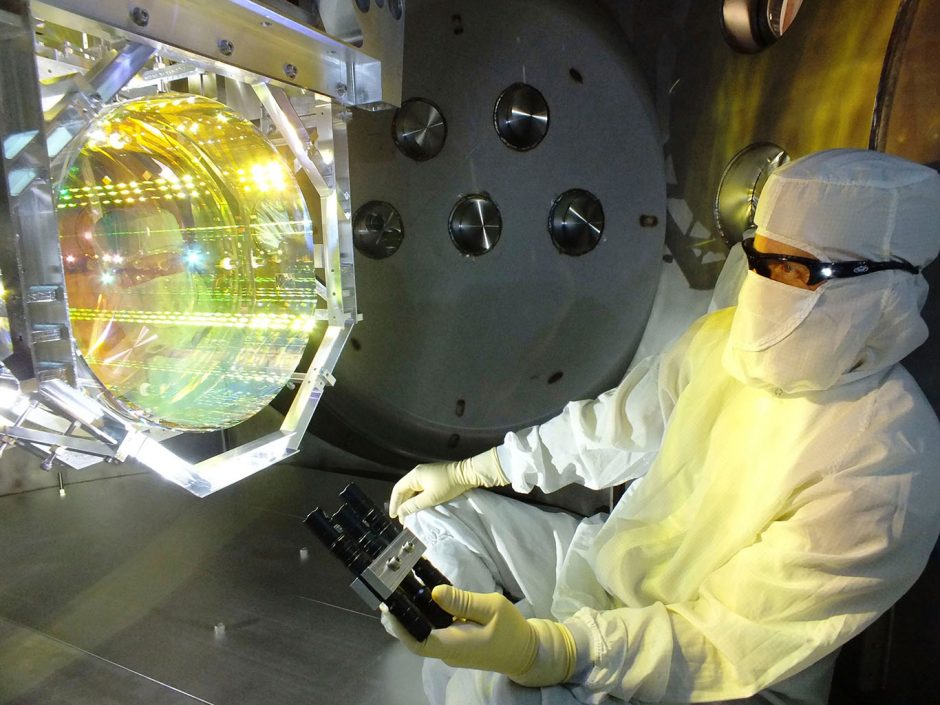
It turned out that the room was full of cats: LIGO’s twin detectors heard a second chirp on December 26, 2015; another pair of black holes had combined, creating a mass 21 times that of our sun and warping space-time. One sun’s worth of mass was converted into energy and carried away by gravitational waves, which reached Earth over a distance-time of 1.4 billion light-years. Analysis of the signal showed that the pair of black holes had orbited each other for years, producing the waves in the last 55 orbits before their epic merger. In other words, the experience of time and space on Earth is infinitesimal compared with the cosmic magnitude of black hole formation and collision. What the discovery confirms is that gravity isn’t just that thing that keeps your things on the table. It’s a curvature in space-time, and movement of a celestial body creates that curvature if it has enough mass. It’s the difference between a mouse running around a trampoline and a human doing the same thing.
“This second detection confirms our expectations that binary black holes are abundant in the universe, and LIGO will see many more in the future,” says Klimenko. The idea that black holes are a common feature of the cosmos is supported by Einstein’s general theory of relativity and the model of the universe as a shifting, expanding sphere. An infinite, static universe is not supported by astronomical evidence (and doesn’t allow for time travel either). Astrophysicists have largely accepted the Big Bang Theory, a misnomer as the model actually describes a convergence of energy so intense that it created matter.
The Big Bang Theory is a comprehensive explanation of the expanding universe and is well backed by evidence from radio astronomy, but scientists have not yet been able to analyze data from the Big Bang itself. Whiting, who has been at UF since 1989, hopes to detect “relic” gravitational waves from the event; this gravitational background is so weak, it requires him to essentially “distinguish noise from noise.” The Big Bang is theorized to have occurred 13.8 billion years ago; in terms of human time, the Big Bang was the ball dropping on New Year’s Eve, and the advent of modern humans is six minutes before the following New Year’s Day.
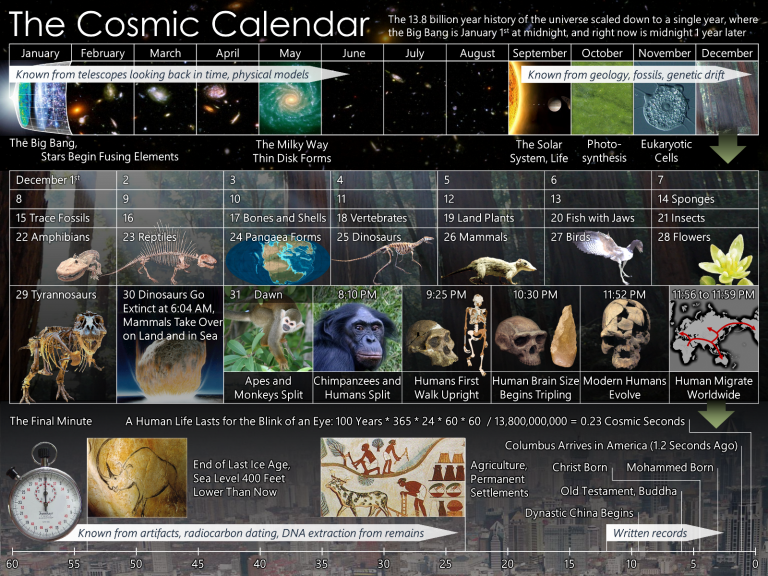
That six minutes has been filled with humans pondering the night sky: “Astronomy has existed as long as people have,” says Mitselmakher, “and has exploded in the last 50 years.” The detection of gravitational waves heralds a new era of multi-messenger astronomy: a confluence of methods and instruments that observes these cosmic events from multiple perspectives.
Indeed, the LIGO Scientific Collaboration, which runs the project, is an international and interdisciplinary group of almost 1,000 scientists, including 26 from UF. “It’s amazing that Reitze was able to coordinate all these people,” says Mueller. “Many of us are not astrophysicists. The strength of the LIGO collaboration is its various enterprises.” Because multiple detections of gravitational waves are the only way to confirm the signal, data is corroborated with that of the Virgo Collaboration, a similar project in Europe. As other detectors set up shop, scientists anticipate a steady stream of discoveries through gravitational astronomy. Interferometers around the globe “may give us triggers to look at our data,” says Tanner. UF’s algorithm was 15 years in the making, says Mitselmakher, and allowed LIGO the unique opportunity to identify the gravitational waves, which arrived at other instruments that did not have sufficient algorithms to pick it up. The program that first detected the waves seen in September 2015, Coherent WaveBurst, was developed in 2004 by the UF LIGO group, a team of faculty, graduate students, and postdocs, and has since undergone continual updating and improvement.
The Big Bang is theorized to have occurred 13.8 billion years ago; in terms of human time, the Big Bang was the ball dropping on new year’s, and the advent of modern humans is six minutes before the following new year’s.
Although LIGO was constructed and is operated by scientists at Caltech and MIT, UF has had an instrumental role (pun intended) in the latest stage, the Advanced LIGO project. From 1996 to present, UF has engineered the “input optics” system, which takes the light from the laser conditions and expands the beam size, and delivers it to the main interferometer, for all of LIGO’s projects. After leading UF’s input optics (IO) program beginning in 1996, Reitze relocated to Caltech, where he currently serves as executive director of LIGO. “The IO was in such a good shape and the entire IO team at UF was so strong that finishing the $5 million project turned out to be fairly straightforward,” said Mueller, who with Tanner has led the team since Reitze’s transfer to Caltech in 2011. Additional support came through a 17-year umbrella grant from the National Science Foundation. The project is still growing, with a third LIGO detector planned for location in India. In the next five years, LIGO hopes to become sensitive enough to detect individual black holes, not just their mergers. Other gravitational wave detector projects include space-based instruments to detect signals from slower events, such as the acceleration of supermassive black holes. The team’s timeline had anticipated these projects to be rolled out by 2034, but Whiting says that they now may be operational as soon as 2030 or 2029.
“We won’t be there to see it, but will guide others,” says Whiting. That hope is shared by the full LIGO team, who have seen many of their students and postdocs go on to work on gravitational wave detection around the world. It’s an exciting new field of cosmic proportions for young scientists, who must work on international collaborative projects at major laboratories. “The idea of the lone professor sitting in his corner inventing something won’t go away,” says Mitselmakher with a sigh. For the UF LIGO team, this new era of multi-messenger astronomy is a paradigm shift towards the collaborative empowerment of extraordinary scientific discoveries.
So is time travel on the horizon? Unlikely. “Interstellar is close to reality [only] as a good way to introduce people to physics,” says Klimenko. Tanner shakes his head in disagreement, but says he does enjoy science-fiction tales of humanity in the face of eternity, such as 2001: A Space Odyssey, Arthur C. Clarke’s 1968 novel (adapted to film by Stanley Kubrick) and Time Enough for Love, the 1973 award-winning novel by Robert A. Heinlein. “The general public is more interested in fantasies than precision,” observes Mitselmakher. Those fantasies of time travel and journeys through the galaxies have gripped humanity since its beginnings. And in this latest millisecond of human existence, cosmically speaking, might be its origins of those fantastic journeys. “This is just the beginning,” says Whiting with a smile.
